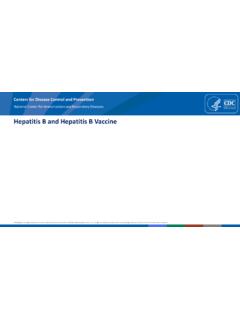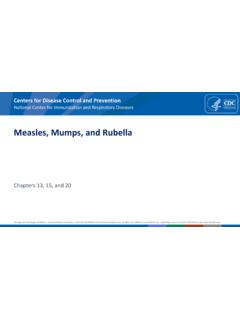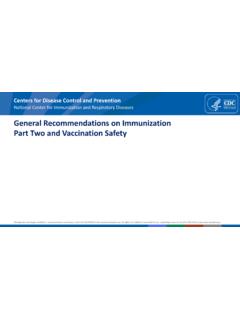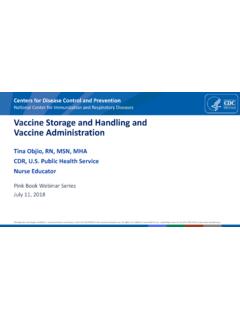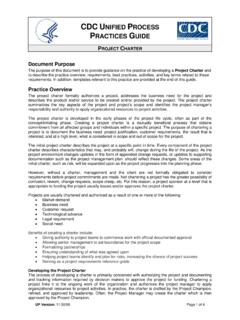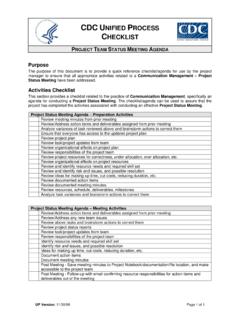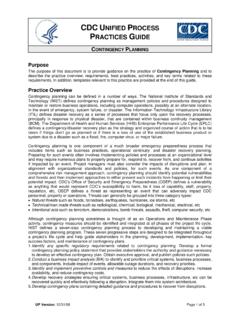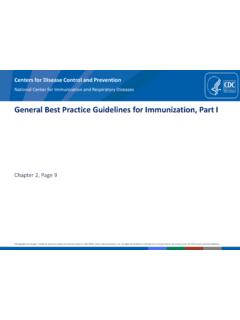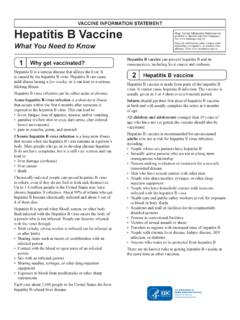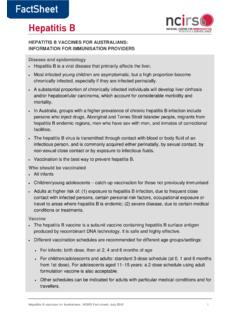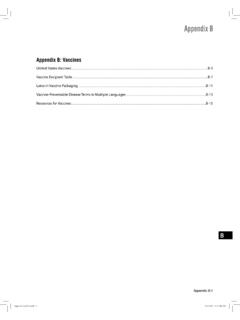Transcription of New Hepatitis A and Hepatitis B Vaccine Recommendations
1 National Center for HIV/AIDS, Viral Hepatitis , STD, and TB PreventionNew Hepatitis A and Hepatitis B Vaccine RecommendationsNoele Nelson, MD, PhD, MPHB ranch Chief (Acting), Division of Viral HepatitisCDC Lead, ACIP Hepatitis Vaccines Work GroupCurrent issues in Immunization WebinarSeptember 25, 2018 Hepatitis A VaccinesUpdate: Recommendations of the Advisory Committee on Immunization Practices for Use of Hepatitis A Vaccine For Post-exposure Prophylaxis and for International Travel Noele Nelson, Ruth Link-Gelles, Megan Hofmeister, Jos Romero, Kelly Moore, John Ward, Sarah Schillie Approved February 2018 ACIP meeting Publication anticipated.
2 November 20183 Hepatitis A Vaccine for Post-Exposure Prophylaxis Recommendations for post-exposure prophylaxis (PEP) for Hepatitis A Hepatitis A (HepA) vaccines should be administered for post-exposure prophylaxis for all persons age 12 months In addition to Hepatitis A Vaccine , IG may be administered to persons age >40 years depending on the providers risk assessment Factors to consider in the decision to use IG in addition to Vaccine Age Immune status and underlying conditions Exposure type (risk of transmission) Availability of IG4 Hepatitis A Vaccine for Post-Exposure Prophylaxis, aged <12 months and persons for whom Vaccine is contraindicated Infants aged <12 months and persons for whom Vaccine is contraindicated (persons who have had a life-threatening allergic reaction after a dose of Hepatitis A Vaccine , or have a severe allergy to any part of this Vaccine ) should receive IG ( mL/kg) instead of Vaccine as soon as possible and within 2 weeks after exposure Note.
3 The recommended interval for administration of MMR Vaccine is no earlier than 3 months after IG administration for Hepatitis A prophylaxis5 Approved; unpublishedHepatitis A Vaccine for Post-Exposure Prophylaxis, aged 12 months Persons aged 12 months who have been exposed to Hepatitis A virus (HAV) within the prior 14 days and have not previously completed the 2- dose HepAvaccine series should receive a single dose of HepAvaccine as soon as possible In addition to HepAvaccine, IG ( mL/kg) may be administered to persons aged >40 years depending on the providers risk assessment For long-term immunity, the HepAvaccine series should be completed with a second dose at least 6 months after the first dose .
4 The second dose is not necessary for PEP6 Approved; unpublishedHepatitis A Vaccine for Post-Exposure Prophylaxis, aged 12 monthswho areimmunocompromised or have chronic liver disease Immunocompromised persons and persons with chronic liver disease who have been exposed to HAV within the prior 14 days and have not previously completed the 2- dose HepAvaccine series should receive both IG ( mL/kg) and HepAvaccine simultaneously in a different anatomical site as soon as possible after exposure For long-term immunity, the HepAvaccine series should be completed with a second dose at least 6 months after the first dose ; the second dose is not necessary for PEP7 Approved.
5 UnpublishedHepatitis A Vaccines for International Travelers Recommendations for pre-exposure protection against Hepatitis A for travelers Hepatitis A Vaccine should be administered to infants age 6-11 months traveling outside the United States when protection against Hepatitis A is recommended The travel-related dose for infants age 6-11 months does notcount towards the routine 2- dose series Therefore, the 2- dose Hepatitis A Vaccine series should be initiated at age 12 months according to the routine, age-appropriate Vaccine schedule8 Hepatitis A Vaccines for International Travelers, IG cannot be administered simultaneously with MMR Vaccine , which is recommended for all infants aged 6 11 months traveling internationally from the , because antibody-containing products such as IG can inhibit the immune response to measles and rubella vaccines for 3 months Due to the greater severity of measles in infancy compared to HAV infection in infancy.
6 MMR Vaccine should be administered preferentially to IG for HAV infection pre-exposure prophylaxis Administration of HepAvaccine (indication for off-label use) and MMR Vaccine to infants aged 6 11 months provides protection against both HAV and measles and allows for simultaneous prophylactic administration 9 Hepatitis A Vaccines for International Travelers, aged <6 months, and travelers who elect not to receive Vaccine or for whom Vaccine is contraindicated Infants aged <6 months, and travelers who elect not to receive Vaccine or for whom Vaccine is contraindicated should receive a single dose of IG ( mL/kg for travel up to 1 month.)
7 ML/kg for travel up to 2 months) prior to travel when protection against Hepatitis A is recommended If travel is 2 months or longer, a repeat dose of mL/kg every 2 months should be administered10 Approved; unpublishedHepatitis A Vaccines for International Travelers, aged 6-11 months Hepatitis A Vaccine should be administered to infants aged 6 11 months traveling outside the United States when protection against Hepatitis A is recommended This Vaccine dose does not count towards the 2- dose series. The 2- dose HepAvaccine series should then be initiated at age 12 months (at any interval after the dose administered for international travel pre-exposure prophylaxis) according to the routine, age-appropriate Vaccine schedule 11 Approved.
8 UnpublishedHepatitis A Vaccines for International Travelers, persons aged >12 months 40 years Healthy persons aged 12 months 40 years who are planning travel to an area with high or intermediate Hepatitis A endemicityand have not received HepAvaccine should receive a single dose of HepAvaccine as soon as travel is considered and complete the 2-does series according to the routine schedule12 Approved; unpublishedHepatitis A Vaccines for International Travelers, adults, immunocompromised persons, persons with chronic liver disease Persons with chronic liver disease as well as older adults (aged >40 years), immunocompromised persons, and persons with other chronic medical conditions planning to depart to a risk area in <2 weeks should receive the initial dose of Vaccine , and also simultaneously can be administered IG at a separate anatomic injection site ( mL/kg for travel up to 1 month at a separate anatomic injection site.)
9 ML/kg for travel up to 2 months; repeat dose of mL/kg every two months)13 Approved; unpublishedHepatitis B VaccinesNew ACIP Hepatitis B Recommendations , January 2018 Schillie S, Vellozzi C, Reingold A, Harris A, Haber P, Ward JW, Nelson NP. Prevention of Hepatitis B Virus Infection in the United States: Recommendations of the Advisory Committee on Immunization Practices. MMWR Recomm Rep 2018;67(No. RR-1):1 31. DOI: ACIP Recommendations Single document with guidance for: Hepatitis B (HepB) vaccination of infants, children, adolescents, and adults Testing pregnant women for Hepatitis B surface antigen(HBsAg), and, if positive, Hepatitis B virus (HBV) DNA HepBpre-vaccination and postvaccinationserologic testing HBV post-exposure prophylaxis (occupational and non-occupational exposures)5 New ACIP Recommendations , cont.
10 Incorporates previously-published Recommendations from: ACIP CDC Augmented with American Association for the Study of Liver Diseases (AASLD) recommendation 8A: The AASLD suggests antiviral therapy to reduce the risk of perinatal transmission of Hepatitis B in HBsAg-positive pregnant women with an HBV DNA level >200,000 IU/mL 6 birth dose All infants born to HBsAg-positive women should receive HepBvaccineand ( Hepatitis B immune globulin) HBIG within 12 hours of birth ,administered at different injection sites Only single-antigen HepBvaccine should be used for the birth dose Recommend Hepatitis B Vaccine birth dose within 24 hours of birth formedically stable infants weighing 2,000 grams and born to HBsAg-negative mothers Aligns with the World Health Organization (WHO) recommendations18 Testing Pregnant Women for HBV DNA HBsAg-positive pregnant women should be tested for HBV DNA toguide the use of maternal antiviral therapy for preventing perinataltransmission (new recommendation)
